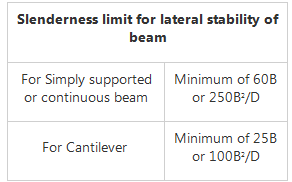Civil Engineering (CE) Exam > Civil Engineering (CE) Questions > The clear distance from the free end of the c...
Start Learning for Free
The clear distance from the free end of the cantilever to the lateral restraint shall not exceed
- a)25 b or 100 b2/d
- b)60 b or 250 b2/d
- c)25 b or 250 b2/d
- d)60 b or 100 b2/d
Correct answer is option 'A'. Can you explain this answer?
Verified Answer
The clear distance from the free end of the cantilever to the lateral ...
As per IS 456:2000, slenderness limit for lateral stability of beam shall be:

Most Upvoted Answer
The clear distance from the free end of the cantilever to the lateral ...
**Explanation:**
In cantilever structures, lateral restraints are used to provide stability and prevent excessive deflection or failure. The clear distance from the free end of the cantilever to the lateral restraint is an important factor in determining the overall stability of the structure.
The equation given to determine the clear distance is:
Clear distance = 25b or 100b^2/d
where b is the width of the cantilever and d is the depth of the cantilever.
Let's analyze the given options:
a) 25b or 100b^2/d
b) 60b or 250b^2/d
c) 25b or 250b^2/d
d) 60b or 100b^2/d
Option A states that the clear distance should not exceed 25b or 100b^2/d. This means that the clear distance can be either 25 times the width of the cantilever (b) or 100 times the square of the width of the cantilever (b^2) divided by the depth of the cantilever (d).
This option provides a conservative limit for the clear distance, ensuring that the cantilever is adequately restrained to prevent excessive deflection. The clear distance should not exceed either of the two values, providing a range within which the cantilever should be restrained.
Options B, C, and D provide larger values for the clear distance, which may result in less restraint and reduce the stability of the cantilever structure.
Therefore, option A is the correct answer as it provides a conservative limit for the clear distance from the free end of the cantilever to the lateral restraint.
In cantilever structures, lateral restraints are used to provide stability and prevent excessive deflection or failure. The clear distance from the free end of the cantilever to the lateral restraint is an important factor in determining the overall stability of the structure.
The equation given to determine the clear distance is:
Clear distance = 25b or 100b^2/d
where b is the width of the cantilever and d is the depth of the cantilever.
Let's analyze the given options:
a) 25b or 100b^2/d
b) 60b or 250b^2/d
c) 25b or 250b^2/d
d) 60b or 100b^2/d
Option A states that the clear distance should not exceed 25b or 100b^2/d. This means that the clear distance can be either 25 times the width of the cantilever (b) or 100 times the square of the width of the cantilever (b^2) divided by the depth of the cantilever (d).
This option provides a conservative limit for the clear distance, ensuring that the cantilever is adequately restrained to prevent excessive deflection. The clear distance should not exceed either of the two values, providing a range within which the cantilever should be restrained.
Options B, C, and D provide larger values for the clear distance, which may result in less restraint and reduce the stability of the cantilever structure.
Therefore, option A is the correct answer as it provides a conservative limit for the clear distance from the free end of the cantilever to the lateral restraint.

|
Explore Courses for Civil Engineering (CE) exam
|

|
Question Description
The clear distance from the free end of the cantilever to the lateral restraint shall not exceeda)25 b or 100 b2/db)60 b or 250 b2/dc)25 b or 250 b2/dd)60 b or 100 b2/dCorrect answer is option 'A'. Can you explain this answer? for Civil Engineering (CE) 2025 is part of Civil Engineering (CE) preparation. The Question and answers have been prepared according to the Civil Engineering (CE) exam syllabus. Information about The clear distance from the free end of the cantilever to the lateral restraint shall not exceeda)25 b or 100 b2/db)60 b or 250 b2/dc)25 b or 250 b2/dd)60 b or 100 b2/dCorrect answer is option 'A'. Can you explain this answer? covers all topics & solutions for Civil Engineering (CE) 2025 Exam. Find important definitions, questions, meanings, examples, exercises and tests below for The clear distance from the free end of the cantilever to the lateral restraint shall not exceeda)25 b or 100 b2/db)60 b or 250 b2/dc)25 b or 250 b2/dd)60 b or 100 b2/dCorrect answer is option 'A'. Can you explain this answer?.
The clear distance from the free end of the cantilever to the lateral restraint shall not exceeda)25 b or 100 b2/db)60 b or 250 b2/dc)25 b or 250 b2/dd)60 b or 100 b2/dCorrect answer is option 'A'. Can you explain this answer? for Civil Engineering (CE) 2025 is part of Civil Engineering (CE) preparation. The Question and answers have been prepared according to the Civil Engineering (CE) exam syllabus. Information about The clear distance from the free end of the cantilever to the lateral restraint shall not exceeda)25 b or 100 b2/db)60 b or 250 b2/dc)25 b or 250 b2/dd)60 b or 100 b2/dCorrect answer is option 'A'. Can you explain this answer? covers all topics & solutions for Civil Engineering (CE) 2025 Exam. Find important definitions, questions, meanings, examples, exercises and tests below for The clear distance from the free end of the cantilever to the lateral restraint shall not exceeda)25 b or 100 b2/db)60 b or 250 b2/dc)25 b or 250 b2/dd)60 b or 100 b2/dCorrect answer is option 'A'. Can you explain this answer?.
Solutions for The clear distance from the free end of the cantilever to the lateral restraint shall not exceeda)25 b or 100 b2/db)60 b or 250 b2/dc)25 b or 250 b2/dd)60 b or 100 b2/dCorrect answer is option 'A'. Can you explain this answer? in English & in Hindi are available as part of our courses for Civil Engineering (CE).
Download more important topics, notes, lectures and mock test series for Civil Engineering (CE) Exam by signing up for free.
Here you can find the meaning of The clear distance from the free end of the cantilever to the lateral restraint shall not exceeda)25 b or 100 b2/db)60 b or 250 b2/dc)25 b or 250 b2/dd)60 b or 100 b2/dCorrect answer is option 'A'. Can you explain this answer? defined & explained in the simplest way possible. Besides giving the explanation of
The clear distance from the free end of the cantilever to the lateral restraint shall not exceeda)25 b or 100 b2/db)60 b or 250 b2/dc)25 b or 250 b2/dd)60 b or 100 b2/dCorrect answer is option 'A'. Can you explain this answer?, a detailed solution for The clear distance from the free end of the cantilever to the lateral restraint shall not exceeda)25 b or 100 b2/db)60 b or 250 b2/dc)25 b or 250 b2/dd)60 b or 100 b2/dCorrect answer is option 'A'. Can you explain this answer? has been provided alongside types of The clear distance from the free end of the cantilever to the lateral restraint shall not exceeda)25 b or 100 b2/db)60 b or 250 b2/dc)25 b or 250 b2/dd)60 b or 100 b2/dCorrect answer is option 'A'. Can you explain this answer? theory, EduRev gives you an
ample number of questions to practice The clear distance from the free end of the cantilever to the lateral restraint shall not exceeda)25 b or 100 b2/db)60 b or 250 b2/dc)25 b or 250 b2/dd)60 b or 100 b2/dCorrect answer is option 'A'. Can you explain this answer? tests, examples and also practice Civil Engineering (CE) tests.

|
Explore Courses for Civil Engineering (CE) exam
|

|
Signup for Free!
Signup to see your scores go up within 7 days! Learn & Practice with 1000+ FREE Notes, Videos & Tests.


















